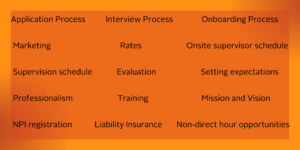Internship Starter Kit Blog Series #2: How to Get Started
By Chris Campassi
Once you have considered your “Why” for hosting an intern, now it is time to start working on “How” to start your internship program. Having managed an Internship program at a Community Mental Health Center with many programs for 2 years, as well as most recently developing an internship program in private practice, I have learned that each site is unique and requires a customized approach to developing an internship program.
As you begin to build your program, I would recommend creating a mission statement and procedural model. While intuitively it might make sense to do this before you reach out to potential Counseling or Social Work Master’s degree programs, you might gain a lot of insight from the programs that can inform your mission and procedures. But before that, let’s make sure you are as prepared as you can be to provide the mentorship and training the internship will need.

Supervision Training Requirements for Internships
While most programs only require a Licensed therapist or social worker to provide supervision for an intern, you may want to consider getting further training on supervision. Clinical supervision requires different skill sets than a therapist, and while you may very well be a great therapist, knowing how to develop an intern is different than providing therapy to a client. Many credentialing entities provide an array of supervision trainings that may be sufficient in preparing you to supervise an intern.
One thing to consider, though, is whether you want to potentially bring this intern on as an employee or contractor after graduation. If this is the case, and you may then end up supervising that individual through their pre-licensure hours, it may make sense to complete the 45-hour Approved Clinical Supervisor training program.
If you live in a state that requires a supervision license to provide supervision, this credential is accepted by most as the preeminent training. If not, this training will likely more than satisfy the requirements of your state to provide supervision for pre-licensed therapists. As always, double check your state’s requirements before making this decision.
Contact Local Master’s Degree Programs
As mentioned above, while you may feel the need to have your program fully developed before partnering with local programs, it may be helpful to first understand each program’s requirements. While most counseling programs follow the CACREP guidelines and are very similar, they do vary from program to program.
For example, some programs will have the students do their entire practicum on campus at their counseling center, and some split between their campus counseling center and a community agency. Or, alternatively, some programs will place their students in a community entity for the entire practicum, if they are an online program or do not have a counseling center on campus.
Students who are doing practicum and internship with you will likely be with you for an entire year, allowing time in practicum to market and prepare a caseload for the intern.
Counseling vs Social Work Programs
 Social Work programs work differently, as any of the social workers reading this will know. Instead of completing much of the academic work prior to practicum and internship the way counseling programs do, most Social Work programs do Field Placements during both the first year, Foundation year, as well as the second, or Concentration year. Social Work programs also will have different requirements for total hours and direct hours, with some not having any direct hour requirement.
Social Work programs work differently, as any of the social workers reading this will know. Instead of completing much of the academic work prior to practicum and internship the way counseling programs do, most Social Work programs do Field Placements during both the first year, Foundation year, as well as the second, or Concentration year. Social Work programs also will have different requirements for total hours and direct hours, with some not having any direct hour requirement.
As you consider the programs you want to work with, be mindful of their requirements for supervision. Counseling program students can be supervised by a Licensed Professional Counselor or Licensed Clinical Social Work, much like provisionally licensed therapists.
Social work programs often require a Licensed Social Workers to provide supervision, but will allow a Licensed Counselor to provide supplemental supervision, training and development. Some schools will even provide the Social Work supervisor and allow a Licensed Counselor to be the primary site supervisor.
Social work field placements and internship only students will likely only be with you for two semesters, so plan accordingly. At our practice, we require any student not doing practicum with us to commit to a full year of internship. This allows us more time and flexibility to meet their direct client contact needs. If you have steady clients to provide and do not need to market specifically to the intern to get clients, this may not be necessary for you.
Apply to be an Approved Site
With all of this in mind, contact the programs you may be interested in working with and set up a time to meet with their Internship or Field Placement Coordinator. Spend time considering the questions you would like to ask, and request a copy of their manual and requirements for becoming an approved site for that program.
If you feel you meet the requirements and can provide the experience necessary for the student, apply for approval. Once approved, they will add you to their approved site list that students use to find internship sites.
Create a Policy and Procedures Manual
As mentioned above, rather than spin your wheels trying to develop your procedural manual, the program manuals will provide a lot of insight into how you want to run your program, or may just give you ideas that you have not thought of already.
Consider getting 2-3 program manuals, reviewing to determine what expectations are universal, and start with those. Once complete with the basic foundation, modify to include provisions that will meet each program’s requirements. Some things to consider include:

Attend an Internship/ Field Placement Fair
Most college and university programs will offer an annual internship fair. This is a great opportunity to market your practice, meet program faculty, and begin talking with potential internship applicants.
While meeting potential interns, you can begin to set expectations for what you will want in an intern, and begin to screen for students that you may want to work with, while screening out interns that you may not feel would be a good fit. Consider your client population, culture of your practice and student’s experience and maturity level as you meet potential interns.
Applications and Interviews
Once you have completed all of the above, it is time to start the selection process. I would recommend creating a clear deadline and application process. Each program has their own deadlines for applications, so be sure that your deadline is prior to the program, else it will be too late for that upcoming semester.
Setting a deadline too early, however, can lead to limited applicants, as they may not yet be applying. I would recommend 1-2 months prior to the school programs deadline.
As applications begin to roll in, you will want to consider if you want to do a “rolling” interview process or “competitive process”. A rolling process entails interviewing your top choice and determining if you want to bring them on before interviewing others. A competitive process entails setting up interviews for several candidates, interviewing, and then offering to your top choice. Each comes with its benefits and drawbacks.
For the rolling process, you can limit the number of interviews that you need to offer, while the competitive process requires more time and effort, but allows you to consider different candidates compared to one another. I don’t think there is a right choice, so do what is best for you and fits best with your practice.
Make an Offer to a Student Intern
Once you have decided whom you want to bring on, make an offer in a formal letter that outlines the expectations you will have for the student, as well as the process for terminating a student who does not meet your requirements. Then have the student sign this form as indication of their acceptance. Having these clear expectations in writing and signed by the student will allow you to take necessary steps if they are not meeting requirements.
Develop a Plan for the Year
Once you have made your decision on who you are bringing on, start planning your schedule for the next year. Think about your onboarding process for employees and what will apply to interns and what will not. Consider what clients your intern will work best with, and how you will match clients with interns.
Assess early on what a student knows and does not know. I recommend assuming very little, and spending time developing a relationship with the intern, understanding how they learn and receive feedback, and providing the necessary training to bridge the knowledge from academic to practical.
How we can help
Be on the lookout for my next blog, which will cover how to make your internship sustainable over time, how to develop your interns from that first supervision until the last, and how to ensure that your intern is prepared to enter the profession once they graduate.
Author Bio

Chris Campassi is an Approved Clinical Supervisor (ACS) and Program Coordinator of Firelight Supervision. He is a licensed psychotherapist in Colorado and North Carolina, blogger, and clinical supervisor for provisionally-licensed and independently licensed therapists. Chris enjoys helping men, medical professionals, and former athletes manage their anxiety and stress so they can live fulfilled and balanced lives. Follow Firelight Supervision on Instagram.



